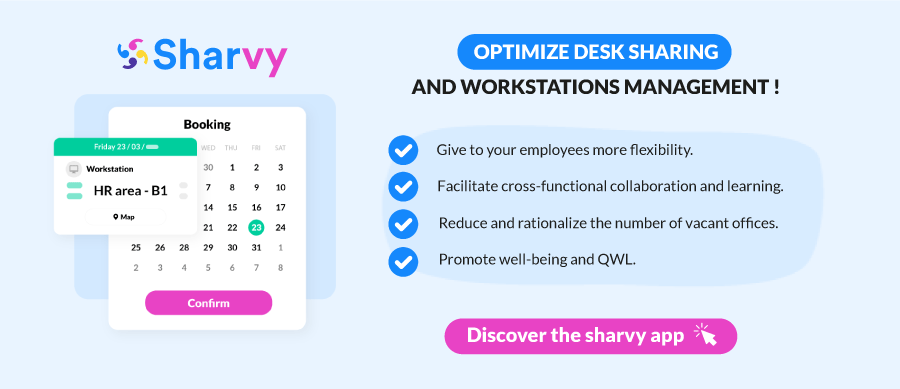Billed as “the way of the future“, flexible working is the opposite of a rigid 9am to 6pm working structure. It is rooted in the freedom to choose when, how, and where to work.
From the status of an option to that of a norm expected by most employees, flexible working is now a new weapon of choice in the war for talent. A weapon that a growing number of companies of all sizes are using to attract a pool of talent from all over the world.
But is flexible working (really) a guarantee of freedom for employees? And are the companies that experiment with it only reaping the benefits? Find the answers in this article.
A quick reminder : what is flexible working?
The flexible working concept still needs better press and a double meaning. On the one hand, negative, and on the other, very positive. It is associated with the uberisation of the labor market and flexibility in which their companies give employees greater freedom and responsibility. It is this second category that we address in this article.
In recent years, more and more employers have recognized that the needs of each employee are unique and are moving away from the traditional 9-6 working day.
As a result, they are giving their employees greater flexibility in organizing their work-life balance. In other words, flexible working is gaining ground, enabling employees who are parents to juggle their commitments (nursery, school, extra-curricular activities, etc.) without constraints.
But how does it work in companies? Flexible working can take many different forms. Here is a (non-exhaustive) list :
- Flexible working hours : In this case, companies stop controlling working time, clocking in and out, and lifting the fixed time slots. Employees have more autonomy and choose their working hours.
- Geographical flexibility : in other words, the “work from anywhere” principle. Companies allow their employees to work from home (telecommuting), from the office, from a third location, and abroad.
- Flexibility in the office : a work organization that has come into fashion recently, also known as “flex office“. In this case, the company no longer allocates a specific workstation to an employee. Once on-site, they choose their anchor point for the day and begin their tasks.
- Flexibility in the organization of work : a much more diffuse concept in which companies can encourage “Job sharing” (two part-time employees who form a full-time pair and share the workload), intrapreneurship, and so on. In these cases, employers offer employees a work organization adapted to their needs for flexibility and autonomy.
Some companies are innovative in this area and devising other forms of flexible working to stand out from the crowd and make it a key asset in their employer brand.
In the final analysis, flexible working is not just a simple work-life balance initiative, it is a process that involves a profound cultural and organizational change in the evolution of business models.
Spotlight on flexible working in Europe : a growing demand from employees?
If Finland has been “World champion” in happiness since 2017, according to the World Happiness Report, it’s not by chance. Undoubtedly, it has something to do with the working patterns of its residents, where the practice of flexible working is shared throughout the country. This is influencing the rest of Europe.
1. Flexible working in the UK.
In the UK, the increased demand for flexible working has been highlighted in a study conducted by Capability Jane. It found that 92% of new generations of workers consider flexibility an absolute priority when choosing a job. At the same time, 70% of British employees believe that flexible working makes a job more attractive to them. Finally, 30% would prefer flexible working to a pay rise.
However, it should be noted that flexible working has taken on a more formal dimension within the country since the creation of dedicated regulations in 2014. As such, Britons working in a company for more than 6 months can request flexible working arrangements. This can include remote working days, flexible working hours, part-time working, job sharing, annualized working hours, etc. The employer must consider the employee’s request and justify any refusal.
2. Flexible working in France.
In France, for example, employees are keen to benefit from a better work-life balance and expect greater flexibility. Moreover, they now have a more “holistic view of work”. Their priorities are the pleasure of coming to work (32%), flexible working hours (33%), and career development (23%), according to a study conducted by the ADP Research Institute in 2022.
An overwhelming majority (64%) stress that they would like to “condense” their working hours and make teleworking an essential prerequisite. Moreover, 36% of French employees say they would resign if it were impossible to telework. This figure rises to 53% among young graduates and recruits (aged 18-25).
3. Flexible working in Spain.
Spain is no exception to the rule, with 64% of Spanish companies succumbing to flexible working (IDG Research study for Logitech and Microsoft). But one trend stands out : the “intensive day” because summer temperatures are too hot to work in the afternoons. Many employers have therefore decided to operate reduced working hours from June to September. Although no law defines this organization’s contours, most companies apply it based on the school holidays. But be warned, finishing earlier also means starting earlier!
Ultimately, of all the European countries, the United Kingdom is the most advanced in flexible working. 83% of British companies authorize one or more forms of flexible working for their employees. At 78%, France ranks second among European countries, ahead of Belgium, Germany and the Netherlands.
The benefits (often unsuspected) of flexible working!
A common misconception is that flexible working only benefits employees. However, this is not the case, as the company may gain far more than the employees. As well as becoming employers of choice, companies that embrace flexible working perform much better. Let’s find out in the paragraphs below.
1. An inexhaustible talent pool & better retention.
It’s no secret that the war for talent has intensified in recent years, forcing companies to redouble their efforts to attract new talent.
Profiles such as developers, marketing specialists, translators, and copywriters expect a flexible working environment. Refrain from offering flexibility in your job advert to avoid turning away a large proportion of the talent pool and reducing your recruitment success.
However, by adopting a more flexible working policy, you are breaking down geographical barriers and allowing yourself to hire a more comprehensive range of profiles with many skills.
Similarly, stay-at-home parents, military spouses, and employees with disabilities can quickly turn to your company if you introduce greater organizational flexibility. A flexible rhythm is much more attractive to these people, who are not in a position to hold a traditional office job with strict working hours.
As a result, flexible working is an advantage recognized by many job seekers. Today, and as we move into the future, these candidates are prepared to choose a job with more flexibility in the organization of work rather than a job that offers better pay but with a presence on site 5 days a week and traditional working hours of 9am to 6pm.
2. Greater commitment from your employees.
What could be more frustrating than always asking your managers for permission to arrive an hour later or leave an hour earlier? Your employees always need clarification when asking for this kind of request.
However, with a flexible working policy and a pre-established framework, they know that they can manage their working hours as they wish, as well as working from home, as long as this remains within the guidelines set by the employer. Moreover, letting your employees choose and modify their working environment as they wish gives them a significant sense of control. Neuroscientists agree that this feeling leads to greater job satisfaction and, ultimately, better performance.
So, offering your employees the chance to develop in a working environment where the triptych of trust, empowerment, and autonomy are at work will encourage their commitment!
3. Improved productivity.
It’s well-known that happy, fulfilled employees are more productive. By offering greater flexibility in how you organize your work, you demonstrate to your employees that you are more than just focused on the company’s results. You show them that you care about their day-to-day lives and the right balance between their professional and personal lives.
At the same time, you take into account everyone’s energy cycles. As you know, productivity levels vary according to the time of day. Some of your employees are early risers and will prefer to condense their working hours to the morning because they feel that this is the time when their productivity is at its highest. Others, on the other hand, prefer to roll up their sleeves after lunch.
By letting your employees organize their working day as they wish, you create the right conditions for them to work effectively.
4. A positive & healthy corporate culture.
When employers allow their employees to work flexibly, they are much better able to cope with the anxieties and stresses of everyday life. In this way, employers can take preventive action against one of the main factors in psychosocial risk.
In the same way, flexible working can be a real (often unsuspected) lever in the fight against burn-out, as well as simply looking after employees’ well-being and Quality of Life and Working Conditions (QWL).
All these elements contribute to a positive and healthy corporate culture. And that, of course, helps to retain talent.
5. A reduction in your property costs.
By working towards a flexible working system, it’s common for your staff to come into the office only two or three times a week. At that point, the allocation of an individual workstation becomes irrelevant.
As a result, you can review your fixed costs and possibly invest in smaller, and therefore less expensive, offices to match the human presence to the surface area used. This is one of the aims of the flex office.
By opting for this form of organization, you should take office-sharing literally by pooling workstations.
However, you need to ensure you optimize your space use. A highly optimized rate (0.5 or 5 workstations per 10 employees) corresponds to a company with ultra-nomadic employees, such as sales representatives. On the other hand, a more anemic rate (0.8) reflects a smooth transition towards the pooling of workstations without constraints and anticipating growth in the workforce. It’s up to you to choose the one that best suits your company.
By pooling your workstations, you can reduce your rent and cut your requirements for office supplies, IT equipment, and premises maintenance services!
Flexible working : what are the risks?
1. The “stowaway” phenomenon & the risk of overwork.
There are certain risks associated with a flexible working environment. Unfortunately, such a system can encourage “free rider” behavior, just as it can encourage some employees to take advantage of this flexibility.
Conversely, flexible working can blur the boundaries between employees’ professional and personal lives, leading to a risk of burnout. They may work longer hours and accumulate overtime without even realizing it. As an employer, consider setting up warning signs so that you can take action if an employee is doing (far) too much and is on the verge of burnout. This is more difficult to “monitor” when employees can work from anywhere.
2. More complex communication and coordination.
Let’s face it : when your staff works different hours, planning meetings and ensuring good internal communication can be more problematic. So, adjust your processes accordingly and favor asynchronous communication to limit information asymmetries. In the long term, miscommunication (about a meeting or a deadline) can create a bad atmosphere within the company.
3. Complicated service continuity management.
It’s clear that specific jobs with a direct relationship with customers require employees to maintain a constant working schedule or, at the very least, be available for conventional working hours to be in line with customers and partners. So, defining a common frame of reference for these jobs is essential to maintaining a good relationship with your customers and prospects.
4. A deserted workspace & a reduced sense of belonging.
Allowing flexible working doesn’t mean that offices have to be deserted. You need to maintain a pleasant working environment, create good rotation between your teams, and make your staff want to come to work.
The absence of daily contact between teams can affect creativity and innovation. This makes it more difficult to maintain cohesion within workgroups. At the same time, it can create isolation and reduce the sense of belonging to the company.
5. Not anticipating your cultural shift.
As you’d expect, flexible working (quite often) goes hand in hand with the flex office. However, your transition to this new work organization brings several challenges. That’s why you need to anticipate your cultural shift. Even if habits change, changing mentalities takes time. Old habits die hard. Your workforce changes and reminders are always beneficial!
So, right from the start of the project, you must recognize the lack of civic-mindedness of some of your employees. Make sure every morning is not a frantic race for the best place by making the right management decisions while sizing the spaces intelligently.
For example, to ensure that early risers are not spoilt for choice and that places become scarce after 9am, introduce a desk-booking tool such as Sharvy. In this way, you depart from the classic flex office approach based on the “first come, first served” principle. Your employees can reserve a place in advance of their arrival.
If you want to turn your vision into an operational reality, don’t hesitate to download our free white paper!
In conclusion : is flexible working (really) synonymous with freedom?
On paper, flexible working seems ideal for both employees and companies.
However, while employees take a more holistic view of work and seek the most comfortable working conditions, this does not mean they are entirely free and fulfilled.
On the other hand, they need to be disciplined and rigorous. Without excellent organization, they can easily fall below the agreed productivity threshold. This will have a direct impact on the company’s performance.
In addition, there is a risk of isolation from the outside world. Added to this are the potential distractions from interruptions caused by family members. The feeling of freedom is, therefore, double-edged. What’s more, it can be altered by the stress resulting from voluntary pressure to achieve set objectives.
As a result, while flexible working makes it possible to avoid ties and hindrances, on the other hand, it gives us a glimpse of a world where relations become less permanent and commitments less categorical.
Have a question? Check out the FAQ!
Why does flexible working (still) get "bad press" in Europe?
Often associated with a negative connotation, flexibility is traditionally associated with an organization imposed on employees by the company : recourse to temporary work, fixed-term contracts, deferred working hours, etc.
In recent years, however, flexible working has taken a new turn. It is flexibility chosen by the employee. In other words, employees can adapt their work organization to their constraints and aspirations.
It’s not the technological tools or the legal framework blocking its development, but rather a corporate culture prioritizes presence over results. Continuing to work late into the evening is (still) seen as a sign of commitment in Europe. However, it’s seen as a sign of inefficiency in the US.
Another cultural barrier is management’s desire for control, whereas management in Anglo-Saxon countries focuses on results and gives more autonomy to its teams…
What are the essential tools for adopting flexible working?
In such an organization, it is crucial to have an inclusive Digital Workplace that is accessible to everyone! This ecosystem of technologies (intranet, applications, organization tools, etc.) enables companies to collaborate remotely and in the workplace. Properly deployed, it increases the business’s agility, flexibility, productivity, and performance.
Several standard but essential elements for successful flexible working (and remote collaboration) can be put in place, for example :
- Email (Gmail, Outlook) & instant messaging applications (Slack).
- Video conferencing tools (Zoom, Teams, Google Meet).
- Data storage in the cloud (Google Workspace, Microsoft 365).
- Collaborative applications & project management tools (Trello, Notion, Asana).
- HRIS (Cegedim SRH, Lucca, etc.).
- Online payroll software (Payfit, ADP, OnPay, OpenPaye, etc.).
At the same time, if a reorganization of workspaces accompanies flexible working, it is essential to offer your employees solutions for reserving a workstation and avoiding numerous pitfalls (lack of space, overbooking, discomfort, dissatisfaction, etc.).
On this point, the Sharvy solution will meet your expectations! Not only does it allow your employees to anticipate their needs up to 4 weeks in advance by reserving a workstation and/or freeing up a designated workstation in anticipation of an absence. But the application also lets you create different zones dedicated to your teams. It helps your staff keep their bearings and smoothly transition to flexible working.
How can flexible work foster creativity and collaborative work while improving workplace well-being?
Flexible work allows not only for adapting the schedules and work locations of nomadic employees but also contributes to improving workplace well-being. By allowing employees to choose their personal workspace or to work in various environments, such as coworking spaces, companies create conditions that stimulate creativity and strengthen collaborative work.
Moreover, by offering a flexible company in terms of work hours, employees can better balance their professional and personal lives, thus reducing stress and absenteeism. Working in varied environments, such as open spaces or dedicated workspaces, also promotes the emergence of new ways of working that are often more productive and in line with the new expectations of employees.
Ultimately, a flexible company does not just adapt to new work modes: it becomes a driver of innovation and well-being for all its employees.
Want to learn more? Check out latest articles!
Smart working : the concept that’s revolutionizing the traditional office?
What is smart working? What are its advantages? Why is this concept overturning the traditional office model? The answers in this article.
Flex office : what are the potential costs and savings?
Flex office may require some initial investment, but it offers companies significant (and often unsuspected) savings! Focus.
Workplace management software : how do you choose your solution?
Faced with a wide choice of Workplace Management software, find out how to choose the right solution for you and its features!
Subscribe to our newsletter!
Resources
Contact us
+44 117 463 6990





